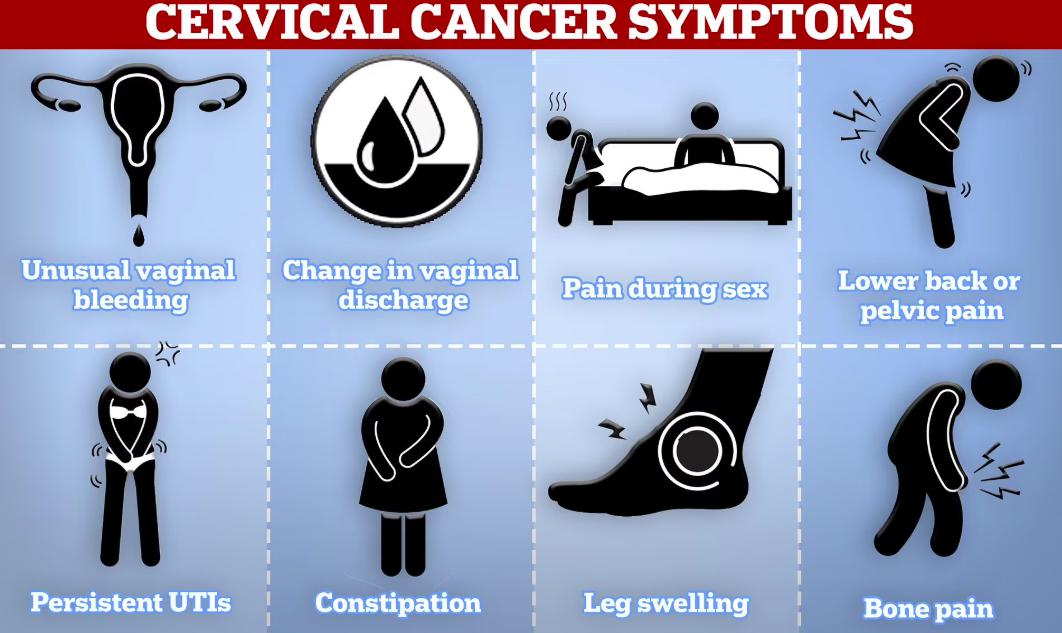Cervical cancer is one of the most common types of cancer affecting women worldwide. It develops in the cervix—the lower part of the uterus that connects to the vagina—and can cause a range of symptoms depending on the stage and spread of the disease. While early stages often show few or no symptoms, advanced cervical cancer can lead to noticeable physical signs, including leg pain.
Many people are unaware that leg pain can be a symptom of cervical cancer, often mistaking it for muscle strain or nerve issues. Understanding why this pain occurs, how it manifests, and what it might indicate is crucial for early detection and treatment. This article explores the link between cervical cancer symptoms and leg pain, along with other vital information about diagnosis, treatment, and prevention.
Definition and Overview
Cervical cancer occurs when abnormal cells in the cervix grow uncontrollably. Most cases are caused by persistent infection with the human papillomavirus (HPV), a sexually transmitted virus. If not detected early, the cancer can spread to nearby tissues and organs, including lymph nodes and nerves, potentially causing pain and discomfort in different parts of the body.
This type of cancer progresses slowly over time, often beginning with precancerous changes known as cervical dysplasia. Regular screening tests like the Pap smear and HPV test can detect these early changes before they turn into cancer.
Types of Cervical Cancer
There are two main types of cervical cancer:
- Squamous cell carcinoma – This type develops in the thin, flat cells lining the outer part of the cervix and accounts for about 90% of cases.
- Adenocarcinoma – This type starts in the glandular cells of the cervical canal and tends to be more difficult to detect early.
In some cases, a mixed type known as adenosquamous carcinoma may occur.
Causes and Risk Factors
The leading cause of cervical cancer is persistent infection with high-risk strains of HPV, particularly HPV-16 and HPV-18. Other contributing risk factors include:
- Early sexual activity and multiple sexual partners
- Weakened immune system (e.g., from HIV infection)
- Smoking
- Long-term use of birth control pills
- Family history of cervical cancer
- Poor nutrition and lack of regular Pap smear screening
Symptoms and Early Warning Signs
In its early stages, cervical cancer may cause no obvious symptoms, making routine screening critical. As the disease progresses, women may notice:
- Abnormal vaginal bleeding (after intercourse, between periods, or after menopause)
- Watery, bloody, or foul-smelling vaginal discharge
- Pelvic or lower back pain
- Pain during sexual intercourse
Cervical Cancer Symptoms: Leg Pain
Leg pain can occur when cervical cancer spreads to nearby tissues and compresses the nerves or lymph nodes in the pelvic region. This pain typically manifests as:
- A dull ache or heaviness in one or both legs
- Swelling in the legs due to blocked lymphatic drainage
- Sharp, shooting pains that worsen when walking or standing
- Tingling or numbness caused by nerve compression
If you experience persistent leg pain alongside other symptoms like pelvic discomfort or unusual vaginal bleeding, it is essential to seek medical evaluation.
Diagnosis
Diagnosing cervical cancer involves several steps:
- Pap smear – Detects abnormal cervical cells.
- HPV testing – Identifies high-risk HPV strains.
- Colposcopy – A closer examination of the cervix using a special microscope.
- Biopsy – A tissue sample is taken for laboratory analysis to confirm cancer.
- Imaging tests – MRI, CT, or PET scans help determine if the cancer has spread, especially to areas causing leg pain.
Treatment Options
Treatment depends on the stage and spread of the cancer. Common approaches include:
- Surgery: To remove cancerous tissue, often through procedures like hysterectomy.
- Radiation therapy: Used to destroy cancer cells and shrink tumors.
- Chemotherapy: Drugs that kill or stop the growth of cancer cells.
- Targeted therapy and immunotherapy: Advanced options for cases resistant to standard treatment.
Managing leg pain may involve medications, physical therapy, and compression techniques to reduce swelling and discomfort.
Prevention and Lifestyle Recommendations
Cervical cancer is highly preventable with proper measures, including:
- HPV vaccination – Recommended for both women and men before becoming sexually active.
- Regular screening – Pap smear and HPV testing every 3–5 years as advised by your healthcare provider.
- Safe sexual practices – Using protection and limiting the number of partners.
- Quit smoking – Smoking weakens the immune system and increases cancer risk.
- Healthy lifestyle – Balanced diet, regular exercise, and adequate rest.
Prognosis and Survival Rates
The prognosis for cervical cancer depends on the stage at diagnosis. When detected early, the 5-year survival rate can reach 90% or higher. However, if the cancer has spread to distant organs or caused severe nerve compression leading to leg pain, the survival rate decreases significantly. Early detection remains the key to better outcomes.
Latest Research and Innovations
Recent studies have focused on immunotherapy, HPV-targeted vaccines, and liquid biopsy tests for earlier detection. Artificial intelligence (AI)-assisted screening methods are also being developed to enhance accuracy and accessibility, especially in low-resource regions.
Coping and Support for Patients
Coping with cervical cancer and its symptoms, including leg pain, can be challenging both physically and emotionally. Support groups, counseling, and physical rehabilitation programs can help manage pain, anxiety, and fatigue. Maintaining open communication with healthcare providers and loved ones plays a vital role in emotional recovery.
Conclusion
Cervical cancer symptoms like leg pain should never be ignored. While leg pain alone does not confirm cervical cancer, it can signal advanced disease when combined with other symptoms such as pelvic pain or abnormal bleeding. Early detection through regular screening and prompt medical attention remains the best defense against cervical cancer.
FAQ
1. Can cervical cancer cause pain in one leg only?
Yes. If the tumor compresses nerves on one side of the pelvis, it can lead to pain or swelling in a single leg.
2. What does cervical cancer leg pain feel like?
It often feels like a dull, aching, or heavy sensation that may worsen over time or when standing for long periods.
3. Is leg pain an early symptom of cervical cancer?
No, leg pain usually appears in the later stages when cancer spreads beyond the cervix.
4. Can cervical cancer be cured?
Yes, especially when diagnosed early. Treatment options like surgery, radiation, and chemotherapy can achieve remission.
5. How can I reduce my risk of cervical cancer?
Get the HPV vaccine, schedule regular Pap smears, avoid smoking, and practice safe sex to significantly lower your risk.


